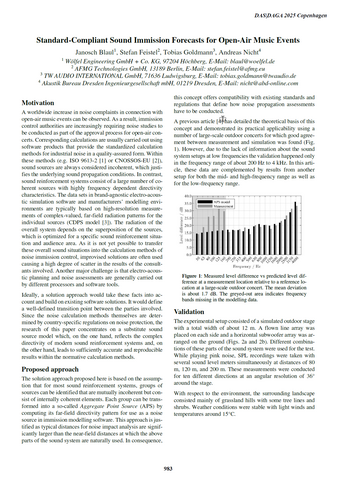Standard-Compliant Sound Immission Forecasts for Open-Air Music Events (Paper)
"Standard-Compliant Sound Immission Forecasts for Open-Air Music Events", paper presented at the DAS/DAGA in Copenhagen, Denmark, March 17-20, 2025.
Link to the paper in the DAGA Online E-Library.
Janosch Blaul
Wölfel Engineering GmbH + Co. KG, Höchberg, Germany
Stefan Feistel
AFMG Technologies GmbH, Berlin, Germany
Tobias Goldmann
TW AUDIO INTERNATIONAL GmbH, Ludwigsburg, Germany
Andreas Nicht
Akustik Bureau Dresden Ingenieurgesellschaft mbH, Dresden, Germany
Abstract:In the operation of modern sound reinforcement systems, large numbers of coherently radiating loudspeakers are managed. Within sound immission control, however, all calculation methods are based on the assumption of incoherent sound sources, which results in an energy summation at the calculation points. To date, this area of conflict has meant that no method has been able to establish itself that does justice to the targeted sound propagation of open-air sound reinforcement systems on the one hand and the normative calculation methods in sound immission control on the other. In a collaboration between representatives of affected companies, i.e. manufacturers of immission control software, of electroacoustic simulation software, and of loudspeaker systems, as well as an engineering office specialising in immission control, a practical approach was developed and validated. It works within the existing regulations on noise protection and with sufficient accuracy - both with regard to the organiser and the person potentially affected by noise. The paper presents the physical principles of the underlying far-field approximation and describes the necessary data interfaces. The metrological verification of the approach using several large outdoor concerts and comprehensive test setups is explained and its practical applicability is demonstrated. A comparison with previously introduced methods and an uncertainty analysis complete the picture.
Practical benefits
This paper addresses the complexities of sound emission modeling for open-air sound systems, providing valuable guidance for minimizing noise pollution and ensuring compliance with environmental regulations. The paper shows that electro-acoustic design software can be used to simulate outdoor sound systems and export far-field directivity data for individual loudspeaker arrays to accurately model their radiation in environmental noise software. These data sets can be calculated in AFMG’s EASE software and then exported to Wölfel’s IMMI software to be used for predicting the impact of the sound system at selected immission points in the neighborhood.
